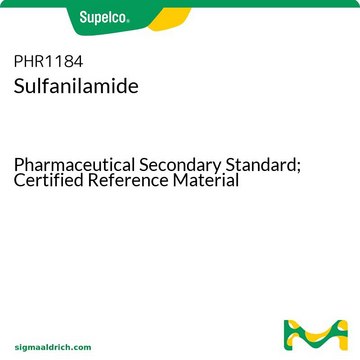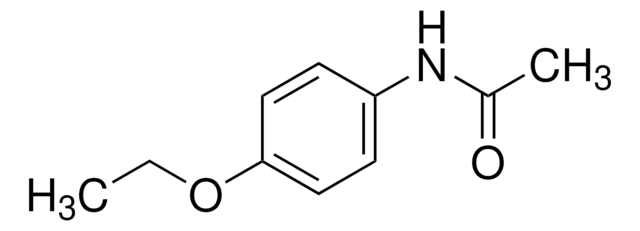1633007
USP
Sulfanilamide Melting Point Standard
United States Pharmacopeia (USP) Reference Standard
Sinônimo(s):
Sulfanilamide, p-Aminobenzenesulfonamide
About This Item
Produtos recomendados
grau
pharmaceutical primary standard
família API
sulfanilamide
fabricante/nome comercial
USP
pf
164-166 °C (lit.)
aplicação(ões)
pharmaceutical (small molecule)
Formato
neat
cadeia de caracteres SMILES
Nc1ccc(cc1)S(N)(=O)=O
InChI
1S/C6H8N2O2S/c7-5-1-3-6(4-2-5)11(8,9)10/h1-4H,7H2,(H2,8,9,10)
chave InChI
FDDDEECHVMSUSB-UHFFFAOYSA-N
Procurando produtos similares? Visita Guia de comparação de produtos
Descrição geral
Aplicação
It was used in a study to demonstrate photodecomposition in aqueous solution of cutaneous photosensitizing agents with the help of spin traps 5, 5-dimethyl-1-pyrroline-1-oxide.
Nota de análise
Outras notas
Código de classe de armazenamento
11 - Combustible Solids
Classe de risco de água (WGK)
WGK 1
Ponto de fulgor (°F)
Not applicable
Ponto de fulgor (°C)
Not applicable
Escolha uma das versões mais recentes:
Certificados de análise (COA)
Lamentamos, não temos COA para este produto disponíveis online no momento.
Se precisar de ajuda, entre em contato Atendimento ao cliente
Já possui este produto?
Encontre a documentação dos produtos que você adquiriu recentemente na biblioteca de documentos.
Nossa equipe de cientistas tem experiência em todas as áreas de pesquisa, incluindo Life Sciences, ciência de materiais, síntese química, cromatografia, química analítica e muitas outras.
Entre em contato com a assistência técnica






